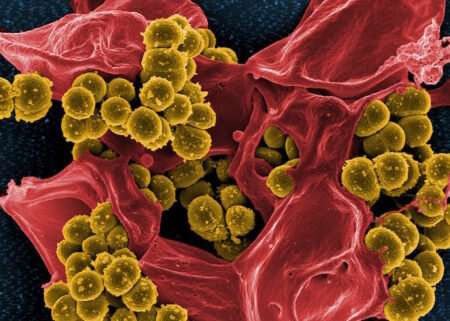Staph's activation of blood clotting

Acute bacterial endocarditis—infection of the inner lining of the heart—is most often caused by the bacteria Staphylococcus aureus ("staph") and has up to a 40% mortality rate.
Staph bacteria circulating in the blood adhere to heart valves and secrete the virulence factor staphylocoagulase (SC), which activates the clotting factor prothrombin to build clot-like "vegetations" on the valves. A previous structural study indicated that the first few N-terminal amino acids in the SC protein insert into a pocket of prothrombin.
Ashoka Maddur, Ph.D., Ingrid Verhamme, Ph.D., and colleagues have now characterized a series of SC fragments with changes in the N-terminal amino acids. They found SC variants that activated prothrombin with similar and higher efficiency compared to wild-type SC and defined the structural requirements of the prothrombin binding pocket.
The findings, reported in the Journal of Biological Chemistry, suggest that staph might change SC to evade the immune response and could guide efforts to develop antibody therapeutics targeted at SC.
More information: Ashoka A. Maddur et al. Specificity and affinity of the N-terminal residues in staphylocoagulase in binding to prothrombin, Journal of Biological Chemistry (2020). DOI: 10.1074/jbc.RA120.012588
Journal information: Journal of Biological Chemistry
Provided by Vanderbilt University



















